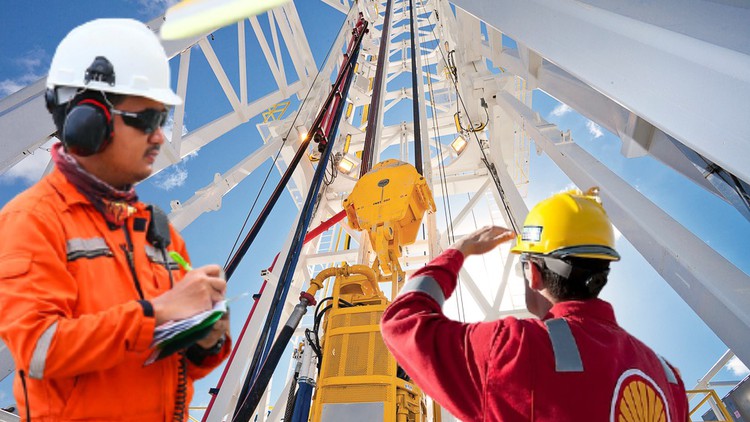
Your definitive unsimilar Guide to Oil & Gas Rigs’ Hoisting system. The most exclusive COURSE on the web.
What you will learn
Identify all Rig hoisting system components (Draw-works, Drilling line, Deadline anchor, Crown-block sheaves, travelling block sheaves,,, etc)
Understand the technical functionality of each component (How it works & the role of each component in relation to the whole system).
Discover what safety equipment the hoisting system includes in all its components & most importantly how to maintain them for a safe & proper functionally
Know how to spot and discover any deficiencies in the hoisting system and thus take prompt corrective actions accordingly.
Be able to create a robust safety and preventative maintenance plans for a safe and effective functionality of the system.
Understand the manufacturer’s OEM relates to the safe use of hoisting system equipment and measurements.
Be aware of the most important & utilized calculation formulas for the draw works speed as well as the drum fleet angle.
Be able to measure the wear on the drum’s le-bus groves & sheaves’ gauges so that the wear is kept within the manufacturer’s OEM.
Be aware of ton-mile calculation procedures as well as slip & cut procedures & processes.
Be aware of bidding requirements of the hoisting system components which is set by the drilling or workover client (Pre-bidding requirements)
Understand the wire rope sling and sheaves relationship (ANSI Standards).
Get full and ultimate knowledge on the hoisting system and therefore be able to answer any related questions in job interviews.
Get a full comprehension on how to carry out a professional and thorough inspection of drawworks, crown block, travelling block, drilling line and ed
Understand the water quality requirements , water additives shall be added to water coolant used in Drawworks as well as Eddy current brake during braking’
Be familiar with all API standards with respect to the Hoisting system equipment ( API standards for equipment Manufacturing as well as API standards)
Description
This course was designed to meet the needs to cover a wide range of HSE professionals and maintenance technicians who have poor knowledge on this particular branch or for those who want to step inside this filed, but unfortunately don’t have the right pieces of information that can back them up.
This course is an exclusive one on the web, It covers all hoisting system aspects, providing so high technical information that would be used to create and set up robust Health and safety checklists as well as preventative maintenance plans.
The course delivers an elaborate explanation of the whole hoisting system components based on years of experience in the field as well as API standards.
The course is made up of six sections, each section describes a particular component with extra details of how it works, the possible defects that can create risks, the relevant technical information as well as an advanced inspection checklist with pictures. Additionally, and most importantly what are the safety-related devices in each component, how do they operate, and how they can be kept performing as per what they are designed for?
The last section of this course explains API standards for all hoisting system components (API Standards for manufacturing, API Standards for inspection categories, and certification validity).
The benefits you gain are valuable and uncountable:
At the end of this course, you will be able to:
- Understand the main role of Drawworks and why it’s considered the most important equipment within the oil and gas rig.
- Understand the mechanism of how each Drawworks’ braking system operates (The Main brake, The parking brake & Emergency brake)
- Become able to perform a thorough inspection of the drawworks inner parts based on a professional checklist backed up with pictures.
- Become aware of the drawworks safety devices and how these devices are kept in good order.
- Understand the role and the importance of having a Twin-Stop system and why it’s considered the most important safety-related device within this system.
- Be aware of the maximum drum recommended speed and what is the formula used to calculate that speed based on the number of hoisting system lines as well as stand length.
- Understand the technical specifications of the drilling line and what right type of drilling line can be selected based on each hoisting system.
- Understand what the fleet angle is, how it can be calculated, and most importantly how to prevent the severe fleet angle from damaging the drilling line via the right installation of drawworks.
- Be aware of wrong work practices and poor maintenance procedures that may affect and damage the drilling line and at the same time what to do to prevent so.
- Be familiar with the anatomy of the crown block and traveling block sheaves and what are safety-related devices to be installed.
- Understand how to measure the groove of the sheaves of both crown block and traveling block in order to prevent drilling line damage.
- Understand what is wobble test and how it’s done!
- Be aware sheaves and wire ropes relationship that is dependent on both diameters and the importance of bending angle (Provided with ANSI standards)?
- Get to know what the tone-mile is with step by step procedure of Drilling line slip and cut.
- Understand what the eddy current brake is, what are its types, how it can be inspected professionally through a professional checklist backup with pictures, what are its safety-related devices and what are its water coolant quality standards.
- You will also be able to understand the technical proposal questionnaires for projects bidding and how to fill them out correctly so that they can be considered relevant and valuable.
- Be able to carry out a professional hoisting system incident investigation providing solutions and accurate corrective actions extrapolated from your deep understanding of the system functionality.
Content